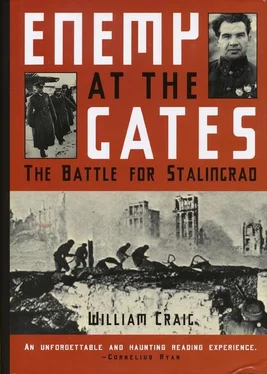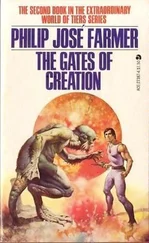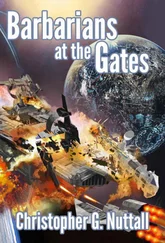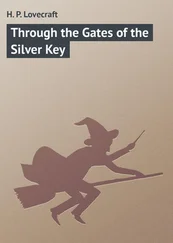Close by, the squat, ugly bulk of the Univermag department store guarded the northeast corner of the square. Once a showroom for fashions from sophisticated Moscow, its counters now held only essential items: underwear, socks, trousers, shirts, coats, and boots. In the Univermag’s gloomy basement warehouse, reserve stocks had sunk to an alarmingly low level.
At the south side of the square, the Corinthian-columned Gorki Theater still hosted a philharmonic orchestra that played regularly in an ornate auditorium festooned with graceful crystal chandeliers hovering over a thousand velvet-backed seats. The theater represented the pinnacle of perfection for Stalingrad’s citizens who resented the city’s reputation as a provincial pretender to culture.
North of Red Square, soldiers clucked horse carts along wide boulevards, past row after row of sterile, white brick apartment houses that looked like barracks. Automobile traffic was minimal and exclusively military in nature. In the evenings, the streets would be filled with pedestrians strolling beneath maple and chestnut trees lining the sidewalks. Many strollers whistled tunes from Rose Marie, which had played for weeks at a downtown theater.
Occasionally, a public garden separated the housing complexes. On Sovietskaya Street, a bank interrupted the residential pattern. A flour mill intnided along Pensenskaya Street. Closer to the Volga, in a library facing the river, a prim matron handed out copies of books by Jack London, a favorite author of the young people.
Neighborhood stores tucked into corner lots competed for business. “Auerbach the Tailor” offered soldiers in ragged uniforms a dingy shop in which quick repairs could be made. Swarms of flies pestered women as they picked over watermelon and tomatoes at open-air markets. Beauty parlors were crowded with girls on off-duty time from war work at the factories.
In the Tsaritsa Gorge, Andrei Yeremenko had already scanned the intersection at Solechnaya Street to assess its military significance. He also examined labyrinthine side roads, off the Ninth of January Square. What really fascinated him was that immediately to the north of Krutoy Gully, the buildings abruptly gave way to a grassy, rock-studded slope rising to a height of 336 feet. This was Mamaev Hill, once a Tartar burying ground and now a picnic area. From there, a casual observer could see most of the city. The view was breathtaking. To the west, there was an uninhabited stretch of steppe country, badly broken by balkas (deep, dried-up riverbeds) and, on the distant horizon, a line of homes and a few church steeples.To the north was the awesome network of industrial plants that had made Stalingrad a symbol of progress within the Communist system. Almost at the base of Mamaev were the yellow brick walls of the Lazur Chemical Plant. They covered most of a city block and were girdled by a rail loop resembling a tennis racquet. From the Lazur, trains puffed north past an oil-tank farm on the bluff beside the river, then on to the Red October Plant with its maze of foundries and calibration shops, from which poured small arms and metal parts. Further north, the trains passed the chimneys and towering concrete ramparts of the Barrikady Gun Factory, whose outbuildings ran back almost a quarter mile to the Volga bank. There a row of workers’ homes languished in an unfinished state. Around the yards of the Barrikady, hundreds of heavy-caliber gun barrels lay stacked, awaiting shipment to artillery units at the front. Beyond the Barrikady loomed the pride of Russian industry, the Dzerhezinsky Tractor Works. Once the assembly point for thousands of farm machines, since the war it was one of the principal producers of T-34 tanks for the Red Army.
Built in eleven months, the tractor factory had opened officially on May 1, 1931, and, when it was completed, it ran for more than a mile along the main north-south road. Its internal network of railroad tracks measured almost ten miles; many workshops had glass roofs to permit a maximum use of sunlight. Ventilation ducts, cafeterias, and showers had been added to the plant to make the workers’ lives more pleasant and productive.
On the other side of the main road, paralleling the eleven miles of industrial park, a special, self-contained innercity had sprung up to accommodate families of factory employees. More than three hundred dwellings, some six-stories high, housed thousands of workers. Clustered around carefully manicured communal parks, they were only a few minutes’ walk from summer theaters, the cinema, a circus, soccer fields, their own stores and schools. Few factory personnel living in this compound ever wanted to leave it. The state had provided almost every basic necessity and the model community that Stalin had fostered was a showpiece of the Soviet system.
From his mental perch on Mamaev, Andrei Yeremenko was not unduly concerned about the view north into the “economic heart” of Stalingrad. Even the most powerful field glasses of an artillery observer, should he chance to be a German, would not be able to penetrate as far as the tractor works, or past it to the uppermost boundary of Stalingrad, the Mokraya Mechetka River.
What alarmed Yeremenko about Mamaev was its staggering vista to the east—down the shimmering Volga, which was jammed daily with hundreds of tugs, barges, and steamers, whistling at each other in riverboat language and trailing wreaths of smoke as they navigated the channels between barren Golodny and Sarpinsky islands. The route they traveled, a vital artery of the Soviet war machine and necessary to any intended defense of Stalingrad, was completely exposed to the whims of the army that possessed the hill. Furthermore, the far shore, which was as flat as a billiard table and stretched into infinity, lay open to observation; so was its lush meadowland, once an amusement park for vacationers who went there to dance or to swim at the pearl-white beaches and to spend weekends at the cottage village near the shore. Now the meadowland was deserted. But through it, in time of need, must come the soldiers, ammunition and food for the relief of Stalingrad. And from Mamaev, an enemy could easily track every boat that left it.
Finished with his exercise, Yeremenko wearily pushed his map away and began issuing orders. Now, more than before, he was determined to dig in firmly along the line of hills that began near Abganerovo. Proper antitank defenses there should delay the German advance. But first he had to scrape up enough manpower for the job.
Above his bunker, a flaming red sun had set; the night air was uncomfortable and muggy. Civilians walked down to the relative cool of the river embankment, where a crowd of evacuees waited for a ferry to arrive from the opposite bank. In a waiting room beside the ferry pier, men and women filled pots of boiling water from giant copper kettles. Some used the water to wash clothing, others to make “tea” from dried apricots or raspberries. It was all they had left.
The dawn of August 7 engulfed the steppe country with a rush of blazing color and burning heat. In the gullies and hollows just outside the thatched huts of the village of Ostrov, twenty miles west of the Don River, Russian soldiers stretched and rubbed their eyes.
Tall, broad-shouldered Maj. Nikolai Tomskuschin faced a special personal dilemma. When, on July 15, he was ordered to take his artillery regiment onto the steppe to protect Sixty-second Army Headquarters, his superior had told him, “In the event of encirclement, save your men before your equipment.” But on July 28, Tomskuschin heard another command, this time from Radio Moscow and Premier Stalin, who told the Red Army to hold at all costs. “Not one step back” was the ultimatum Stalin issued.
As his men ate breakfast, German planes appeared overhead and Tomskuschin called Sixty-second Army Headquarters for further guidance. The line was dead. “Hello! Hello!,” he shouted. No one answered. The major dropped the phone and ran to find someone on the staff who could give him new orders. But he was stunned to find that Sixty-second Army Headquarters had disappeared. His commanders had fled to Stalingrad.
Читать дальше












